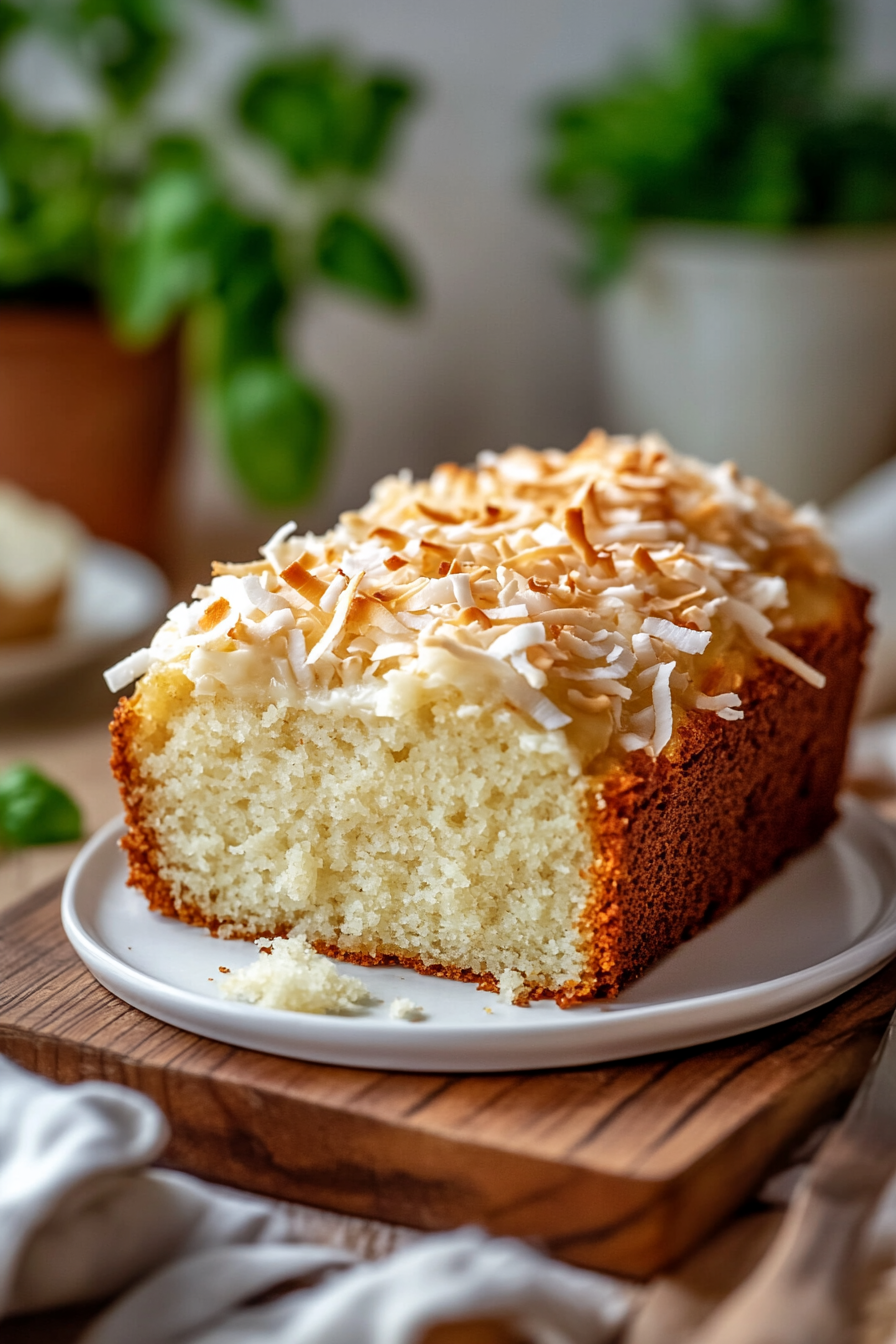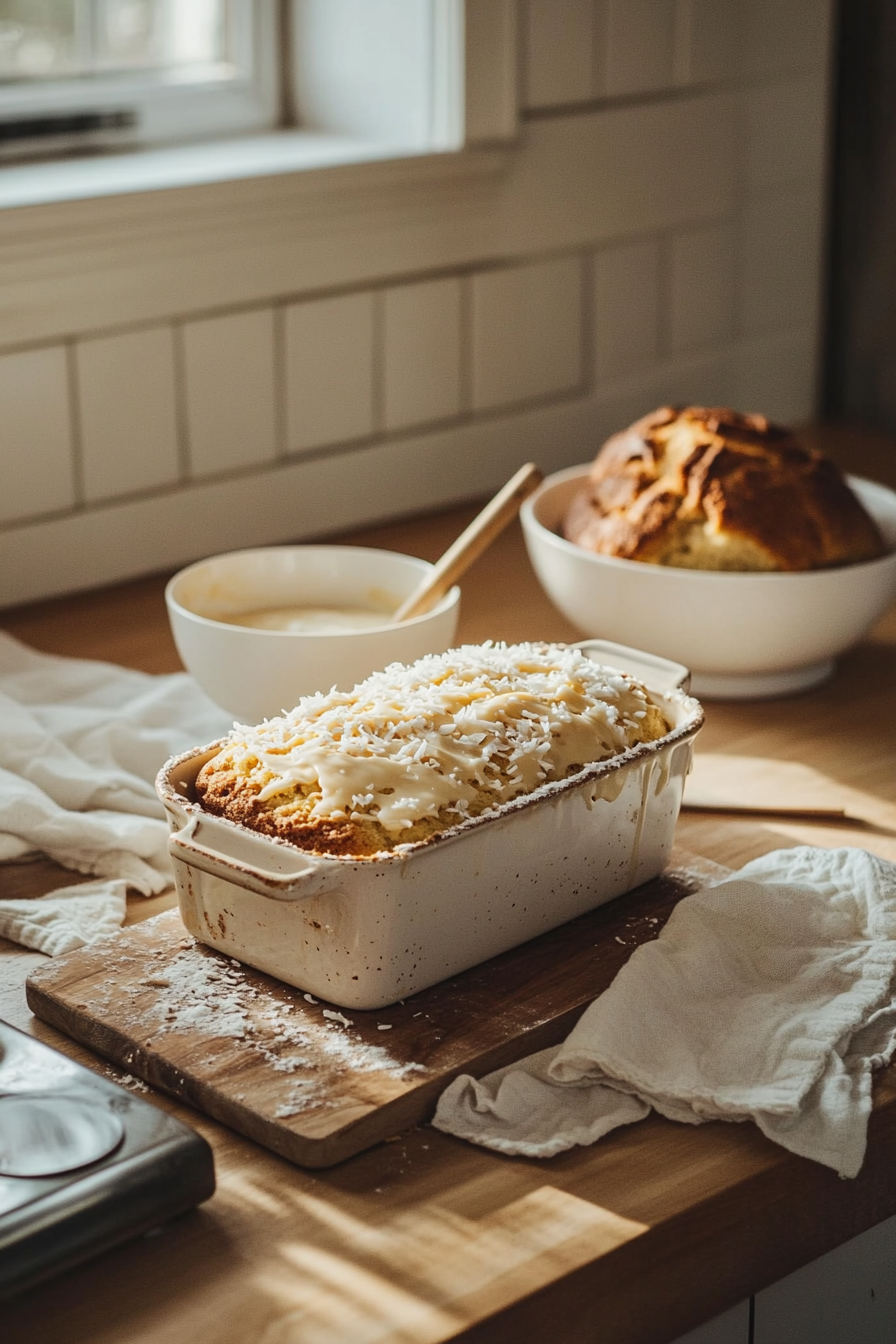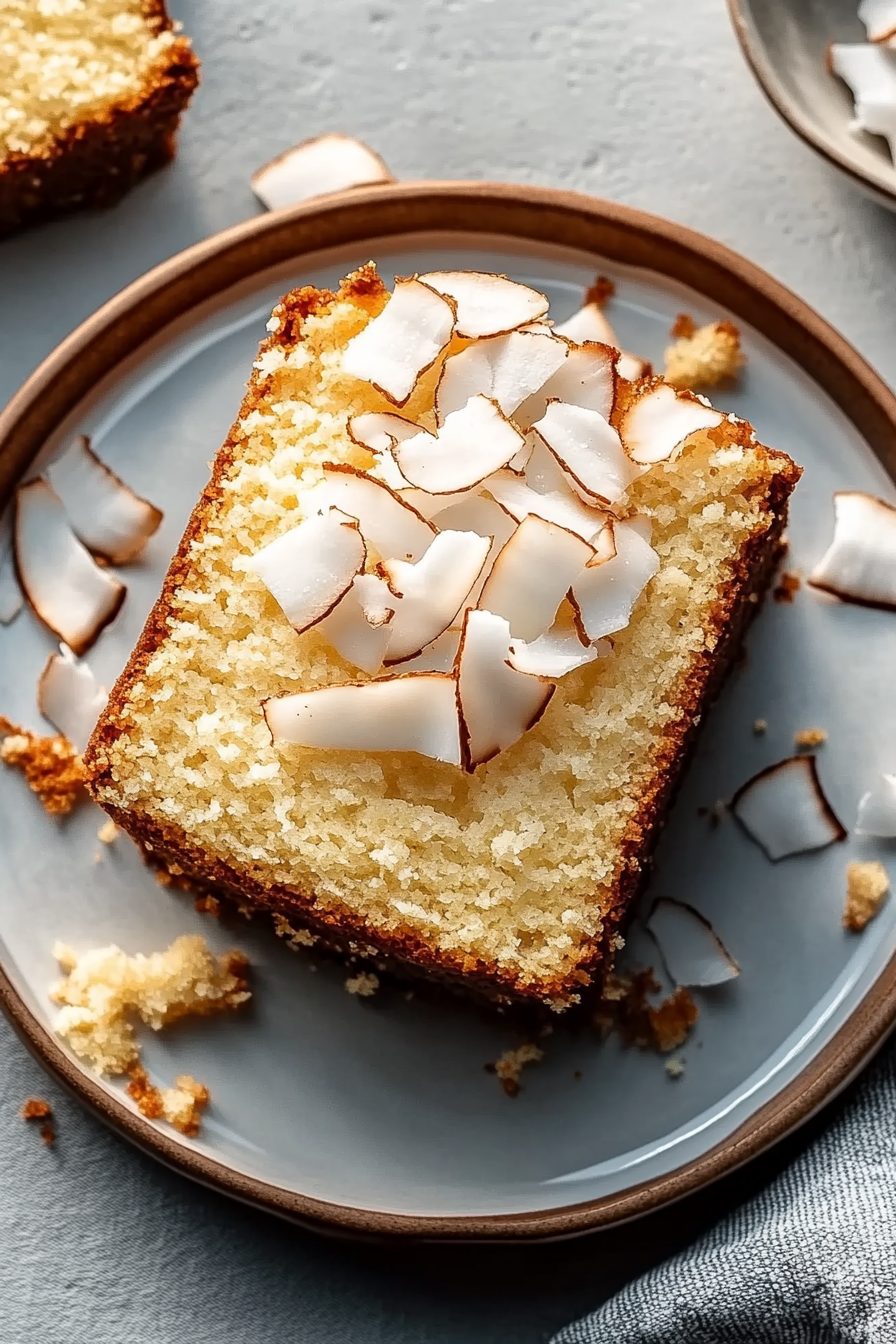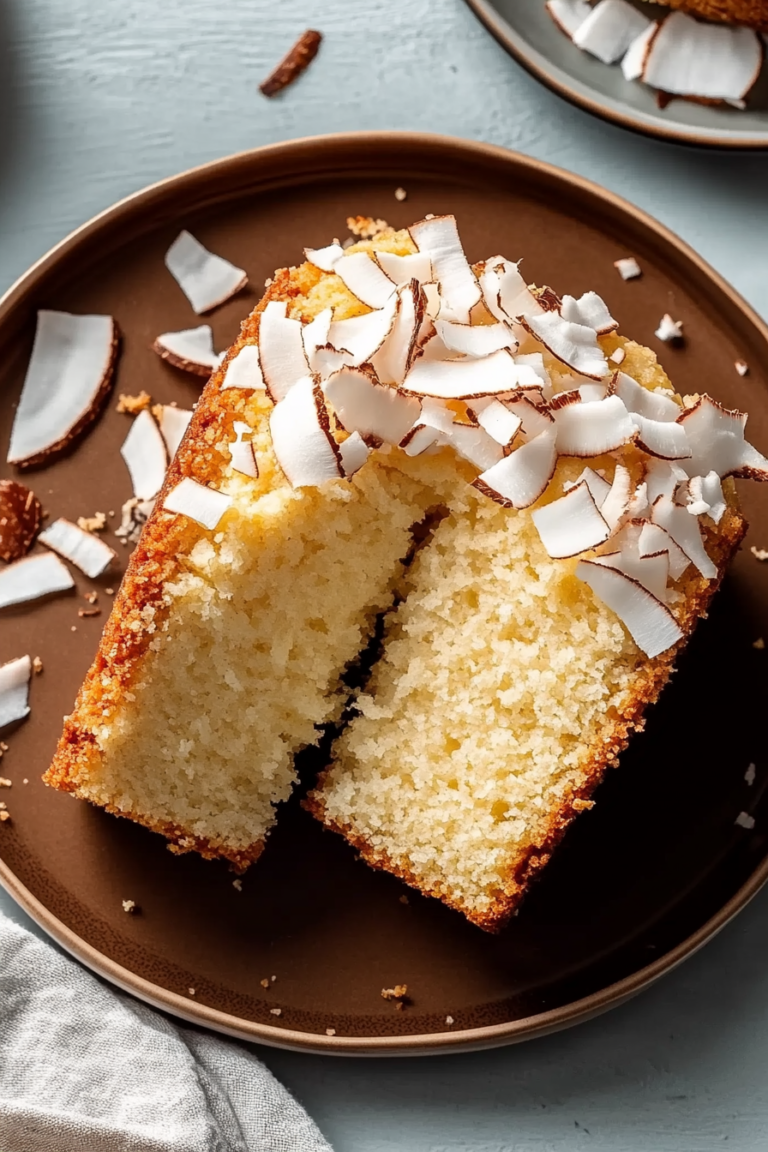Mastering triple coconut loaf cake
The triple coconut loaf cake is a delightful treat that brings the tropical flavors of coconut into a classic pound cake form. It’s prized for its moist texture and balanced sweetness, achieved by layering coconut in three different ways: coconut milk, coconut extract, and shredded coconut. This unique layering of flavors makes every bite a rich and satisfying experience.
Perfect for home bakers of all levels, this recipe is both straightforward and rewarding. With simple ingredients often found in most kitchens, the triple coconut loaf cake invites you to enjoy a luscious dessert without the fuss. Its versatility is another appealing factor—you can serve it as an afternoon snack, a festive dessert, or a comforting breakfast alongside coffee or tea.
Not only is it delicious, but this loaf cake also has a comforting, homemade quality that connects families and friends around the table. For those interested in a tropical twist to traditional baking, embracing the full-bodied flavor of coconut in this way is an excellent choice.
Using full-fat canned coconut milk adds creamy richness that enhances the crumb, while shredded sweetened coconut infuses chewy bursts of texture. The subtle hint of coconut extract layers on top of the coconut milk’s mellow taste, delivering a truly indulgent sensory experience. For tips on executing the perfect pound cake technique, check this comprehensive guide on pound cake baking.

Jump To
- 1. Mastering triple coconut loaf cake
- 2. Benefits and Advantages of triple coconut loaf cake
- 3. Essential Ingredients for triple coconut loaf cake
- 4. Dietary Substitutions to Customize Your triple coconut loaf cake
- 5. How to Prepare the Perfect Triple Coconut Loaf Cake: Step-by-Step Guide
- 6. Mastering Triple Coconut Loaf Cake: Advanced Tips and Variations
- 7. How to Store Triple Coconut Loaf Cake: Best Practices
- 8. Nutritional Value of Triple Coconut Loaf Cake
- 9. FAQs: Frequently Asked Questions About Triple Coconut Loaf Cake
- 10. Irresistible Triple Coconut Pound Cake: A Tropical Flavor Journey for Your Palate
Benefits and Advantages of triple coconut loaf cake
Simple Preparation with Accessible Ingredients
One of the main benefits of the triple coconut loaf cake is its easy preparation. The ingredients are commonly available, and the method typically involves straightforward mixing and baking steps that even beginner bakers can follow with confidence. The use of pantry staples like butter, sugar, and flour, combined with tropical coconut ingredients, make it a convenient recipe to prepare without hunting down specialty items.
Rich Tropical Flavor While Staying Comfortably Sweet
The triple coconut loaf cake offers a wonderful balance of sweetness and coconut essence without being overpowering. The flavor profile is layered and satisfying thanks to the interplay of vanilla and coconut extracts paired with natural coconut milk. This makes it appealing to a wide audience—from children to adults—who appreciate a flavorful yet familiar dessert.
Texture That Combines Moistness and a Gentle Crunch
Thanks to the shredded sweetened coconut folded into the batter, the texture of the loaf becomes multi-dimensional. This addition gives each slice a pleasantly chewy consistency alongside the soft crumb structure. The coconut glaze with sprinkled coconut on top adds a subtle crunch, enriching the eating experience.
Nutritional Highlights and Dietary Considerations
While this cake is a sweet indulgence, using coconut milk provides a different fat profile than typical milk, including medium-chain triglycerides that some studies suggest may offer metabolic benefits. For more on the nutritional benefits of coconut milk, readers will find helpful information to understand its place in a balanced diet.
Moreover, this recipe can be adapted for various dietary preferences, such as substituting ingredients for vegan or gluten-free versions, which makes it highly flexible.

Essential Ingredients for triple coconut loaf cake
To create the perfect triple coconut loaf cake, using the right ingredients in proper amounts is vital. Below is a detailed list of all ingredients needed for both the pound cake and the glaze, presented with precise measurements to guide your baking.
| Ingredient | Quantity | Purpose or Benefit |
|---|---|---|
| Unsalted butter | 1 1/2 sticks (12 tablespoons), room temperature | Provides richness and tenderness to the crumb |
| Granulated sugar | 1 cup | Sweetens and helps with cake structure |
| Eggs | 2 large, room temperature | Bind ingredients and add moisture |
| All-purpose flour | 1 3/4 cups | Main structure of the cake |
| Baking powder | 1 teaspoon | Leavening agent for rise |
| Baking soda | 1/4 teaspoon | Enhances rise and balances acidity |
| Salt | 1/2 teaspoon | Enhances flavors |
| Full-fat canned coconut milk | 1 cup | Adds moisture and coconut richness |
| Vanilla extract | 1 teaspoon | Provides a warm, sweet aroma |
| Coconut extract | 1/2 teaspoon | Amplifies coconut flavor without overpowering |
| Shredded sweetened coconut | 1 cup | Adds texture and bursts of coconut flavor |
| Confectioner’s sugar (for glaze) | 1 1/2 cups | Sweet base for glaze |
| Coconut milk (for glaze) | 4 to 5 tablespoons to thin | Adjusts consistency and adds coconut taste |
| Vanilla extract (for glaze) | 1/4 teaspoon | Enhances glaze flavor |
| Salt (for glaze) | Pinch | Balances sweetness |
| Shredded sweetened coconut (for topping) | As needed | Garnish and extra texture |
This ingredient list is fundamental for recreating the luscious taste that defines the triple coconut loaf cake. For tips and tricks on incorporating shredded coconut into your baked goods, visit this expert guide on baking with shredded coconut.
Dietary Substitutions to Customize Your triple coconut loaf cake
Catering to different dietary needs or ingredient availability can be achieved with simple substitutions in the triple coconut loaf cake recipe. Here are some helpful alternatives to customize the cake while maintaining its delicious coconut charm.
Vegan Modifications
- Butter: Replace with an equal amount of coconut oil or vegan buttery spread to keep the coconut flavor prominent and add moisture.
- Eggs: Use flax eggs (1 tablespoon ground flaxseed + 3 tablespoons water per egg) to bind the batter naturally.
- Coconut milk: Full-fat canned coconut milk is already vegan-friendly; ensure the sweetened shredded coconut uses no animal-derived ingredients.
Gluten-Free Options
- Flour: Substitute all-purpose flour with a gluten-free blend formulated for baking. Make sure it contains a binding agent like xanthan gum for texture.
- Expect minor changes in crumb texture; adjust baking time as needed.
Lower Sugar and Calorie Alternatives
- Sugar: Reduce granulated sugar slightly or substitute with natural sweeteners like coconut sugar or erythritol in equal parts.
- Glaze: Use a sugar-free powdered sweetener for the glaze or omit entirely if preferred.
Dairy-Free Adaptations
- Butter: Use refined coconut oil or plant-based margarine to avoid dairy flavors.
- Milk Substitutions: Stick to canned coconut milk for flavor and fat content; plant-based milks will alter texture.
These substitutions allow you to tailor the triple coconut loaf cake to your dietary needs or ingredient preferences. Experimenting with these options can help you create a version of the cake everyone can enjoy without sacrificing texture or flavor.
For ideas on baking delicious bread alternatives, visit our recipe for banana bread cake with cream cheese frosting, which also offers helpful tips on adapting classic recipes.
“Small adjustments in ingredients can open up new worlds of flavor and inclusivity in baking.”

How to Prepare the Perfect Triple Coconut Loaf Cake: Step-by-Step Guide
Creating the perfect triple coconut loaf cake is a rewarding baking project that fills your kitchen with enticing tropical aroma and yields a moist, flavorful treat. Follow this straightforward, step-by-step method to get delicious results every time.
First Step: Prepare Your Pan and Ingredients
- Preheat your oven to 350°F (175°C) to ensure it’s ready when your batter is mixed.
- Grease a 9×5 inch loaf pan thoroughly and line it with parchment paper. This will make cake removal easier and prevent sticking.
- Sift together the dry ingredients—1 3/4 cups all-purpose flour, 1 teaspoon baking powder, 1/4 teaspoon baking soda, and 1/2 teaspoon salt—into a bowl. This helps distribute them evenly and avoids lumps.
Second Step: Cream Butter and Sugar
- In a separate mixing bowl, beat 1 1/2 sticks of unsalted butter (12 tablespoons) at room temperature with 1 cup granulated sugar until the mixture is light and fluffy. This aeration step is crucial for a tender crumb.
Third Step: Incorporate Eggs and Flavorings
- Add 2 large room temperature eggs, one at a time, beating well after each addition to maintain emulsion.
- Mix in 1 teaspoon vanilla extract and 1/2 teaspoon coconut extract to infuse the cake with its distinct tropical taste.
Fourth Step: Fold in Dry Ingredients and Coconut Milk
- Alternately fold in the sifted dry ingredients and 1 cup full-fat canned coconut milk, starting and ending with the dry ingredients. Folding rather than vigorous mixing keeps the batter light.
Fifth Step: Add Shredded Coconut and Bake
- Gently fold in 1 cup shredded sweetened coconut to distribute the texture and boost coconut flavor.
- Pour the batter evenly into the prepared loaf pan, smoothing the top.
- Bake in the preheated oven for 60 to 65 minutes. Keep an eye on the cake; if the top browns too quickly, tent with foil to prevent burning.
- Use a toothpick inserted into the center to check doneness—it should come out clean.
Sixth Step: Cool and Glaze
- Allow the cake to cool in the pan for 10 minutes before transferring it to a wire rack to cool completely.
- For the glaze, mix 1 1/2 cups confectioner’s sugar with 4 to 5 tablespoons coconut milk, 1/4 teaspoon vanilla extract, and a pinch of salt until thick but spreadable.
- Spread the glaze over the cooled cake and sprinkle with additional shredded sweetened coconut as a finishing touch.
This step-by-step method ensures a well-balanced, moist, and aromatic pound cake that’s packed with luscious coconut flavor. For extra detailed guidance on making pound cake, check out this expert resource on perfect pound cakes.
Mastering Triple Coconut Loaf Cake: Advanced Tips and Variations
Tips to Nail Your Coconut Loaf Every Time
- Select quality shredded coconut: Use moist, sweetened coconut flakes for the best texture and flavor burst. This avoids dryness and adds chewiness.
- Butter or coconut oil? Try substituting a portion of the butter with coconut oil for a deeper coconut flavor while keeping the crumb tender.
- Rotate your cake: Halfway through baking, turn the pan to promote even cooking and browning.
- Cool upside down: After baking, cool the cake upside down on the rack to help the loaf retain moisture and maintain its shape.
- Tent foil for controlled browning: Protect the top if it browns too fast; this prevents burnt spots while the inside finishes baking.
Flavor Variations to Try
You can customize your triple coconut loaf cake by adding interesting mix-ins or complementary flavors:
- Citrus zest: Adding a teaspoon of grated lime or orange zest brings a fresh contrast to the rich coconut.
- White chocolate chips: Fold in 1/2 cup for a sweet, creamy surprise in each bite.
- Pineapple icing garnish: For a tangy tropical touch, serve with a pineapple-flavored icing to balance the sweetness.
These variations keep the triple coconut loaf cake exciting for repeat bakers and adventurous eaters alike. For more baking insights, explore best tips for baking with shredded coconut.
How to Store Triple Coconut Loaf Cake: Best Practices
Keeping Your Cake Fresh and Moist
Proper storage of your triple coconut loaf cake is essential to maintain its moisture, flavor, and texture.
Room Temperature Storage
- Wrap the cooled cake tightly in plastic wrap or place in an airtight container.
- Store at room temperature for up to 2 days.
- This approach preserves the delicate crumb without the chill that can dry the cake.
Refrigeration
- If keeping longer than two days, refrigerate the cake wrapped well to prevent it from absorbing fridge odors.
- The cake can last up to one week refrigerated but may firm up; bring to room temperature before serving.
Freezing for Extended Storage
- For long-term storage, wrap the cake in plastic wrap followed by a layer of aluminum foil.
- Freeze for up to three months.
- To thaw, transfer the cake to the refrigerator overnight, then bring to room temperature before glazing and serving.
- For best results, apply glaze after thawing to avoid it melting or becoming runny.
“Freezing your triple coconut loaf cake is a great way to enjoy it whenever you want—a delicious slice awaits after simple thawing.”
Nutritional Value of Triple Coconut Loaf Cake
This indulgent tropical dessert not only pleases the palate but also offers insight into its nutritional content to help you enjoy responsibly.
| Nutrient | Amount per Serving (Approx. 12 servings) |
|---|---|
| Calories | 403 kcal |
| Total Fat | 23g |
| Saturated Fat | 16g |
| Cholesterol | 61mg |
| Sodium | 140mg |
| Total Carbohydrates | 48g |
| Sugars | 32g |
| Dietary Fiber | 2g |
| Protein | 4g |
The inclusion of full-fat canned coconut milk adds rich fats, including saturated fats, but also beneficial nutrients associated with coconut. Learn more about the nutritional benefits of coconut milk here.
This cake is a delightful treat with a moderately high calorie and fat content, so enjoying a slice in moderation fits well within a balanced lifestyle. It is perfect for special occasions or as a comforting dessert.

FAQs: Frequently Asked Questions About Triple Coconut Loaf Cake
What type of coconut should I use for a triple coconut loaf cake?
For the best texture and flavor, use moist, sweetened shredded coconut such as Baker’s Angel Flake Coconut. This type sticks well in the batter and melts slightly during baking to impart both flavor and chewiness. Unsweetened or dry coconut can also be used but may result in a drier texture. For those with dietary restrictions, unsweetened or low-fat options are available but may alter the sweetness and mouthfeel.
Can I substitute coconut extract in the triple coconut cake recipe?
Yes, if you don’t have coconut extract, you can use vanilla extract as a substitute. While this will slightly change the flavor profile by reducing the distinct coconut aroma, the cake will still taste delicious due to the shredded coconut and coconut milk. Coconut extract is available in most grocery stores or online and adds a more authentic coconut flavor.
How do I freeze and thaw a triple coconut loaf cake properly?
To freeze, wrap the cooled cake securely in plastic wrap, then cover with aluminum foil to prevent freezer burn. Store it in an airtight container or heavy-duty freezer bag. When ready to enjoy, thaw the cake in the refrigerator overnight. Apply the glaze after thawing for best texture and taste, as pre-glazing before freezing can cause the glaze to become sticky or watery after thawing.
Can the triple coconut loaf cake recipe be used to make muffins?
Absolutely. Use muffin tins and grease or line them with muffin cups. Fill each cup about two-thirds full with the batter. Bake at 350°F, reducing the time to around 18-22 minutes. Muffins may bake faster due to their smaller size. This variation gives you portable, individual coconut treats with the same rich flavor.
What is the best way to store a triple coconut loaf cake to keep it fresh?
Store the cake wrapped tightly at room temperature for up to 2 days, which best preserves texture. Beyond that, refrigerate in an airtight container for up to a week. For longer storage, freeze the cake wrapped well and thaw as needed. These methods maintain its moist crumb and rich coconut flavor.

Irresistible Triple Coconut Pound Cake: A Tropical Flavor Journey for Your Palate
🥥 Experience a slice of paradise with this Triple Coconut Pound Cake. Indulge in layers of rich coconut flavors, from moist cake to luscious glaze.
🌴 Perfect for any occasion, this delightful treat brings tropical vibes straight to your dessert table.
- Total Time: 1 hour 20 minutes
- Yield: 12 servings 1x
Ingredients
1 1/2 sticks unsalted butter (12 tablespoons) at room temperature
1 cup granulated sugar
2 large eggs, at room temperature
1 3/4 cups all-purpose flour
1 teaspoon baking powder
1/4 teaspoon baking soda
1/2 teaspoon salt
1 cup full-fat canned coconut milk
1 teaspoon vanilla extract
1/2 teaspoon coconut extract
1 cup shredded sweetened coconut
1 1/2 cups confectioner’s sugar
4 to 5 tablespoons coconut milk to thin
1/4 teaspoon vanilla extract
Pinch of salt
Shredded sweetened coconut for topping
Instructions
1. Preheat oven to 350°F (175°C) and prepare a 9×5 inch loaf pan by greasing and lining with parchment paper.
2. In a bowl, sift together the flour, baking powder, baking soda, and salt.
3. In another bowl, cream the butter and granulated sugar until light and fluffy.
4. Beat in the eggs, one at a time, mixing well after each addition.
5. Alternately fold in the dry ingredients and coconut milk mixed with vanilla and coconut extracts into the creamed mixture.
6. Gently fold in the shredded coconut until evenly distributed.
7. Pour the batter into the prepared pan and smooth the top.
8. Bake in the preheated oven for 60-65 minutes, tenting with foil if the top browns too quickly.
9. Check for doneness with a toothpick; it should come out clean.
10. Cool the cake in the pan for 10 minutes, then transfer to a wire rack to cool completely.
11. For the glaze, combine confectioner’s sugar, coconut milk, and vanilla extract to achieve a thick consistency, and mix in a pinch of salt.
12. Once the cake is cool, spread the glaze over the top and sprinkle with shredded coconut for decoration.
Notes
🥥 Use high-quality, moist shredded sweetened coconut for the best texture.
⚖️ Coconut oil can be a substitute for part of the butter for added richness.
🍋 For a twist, consider adding citrus zest or white chocolate chips.
- Prep Time: 15 minutes
- Cook Time: 60-65 minutes
- Category: Dessert
- Method: Baking
- Cuisine: Tropical
- Diet: Vegetarian
Nutrition
- Serving Size: 1 slice
- Calories: 403 kcal
- Sugar: 32g
- Sodium: 140mg
- Fat: 23g
- Saturated Fat: 16g
- Carbohydrates: 48g
- Fiber: 2g
- Protein: 4g
- Cholesterol: 61mg







